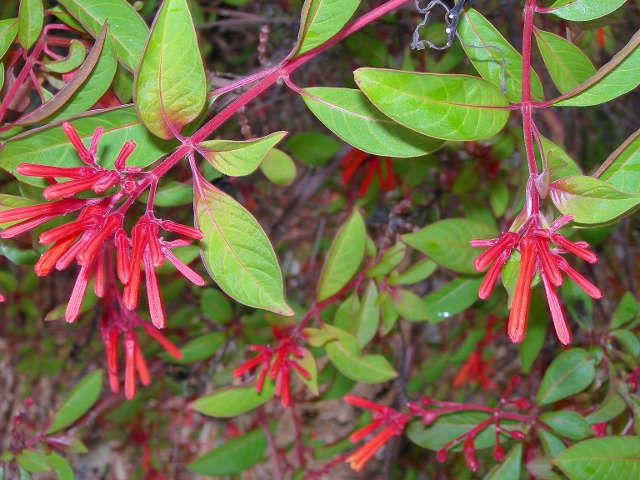For several years, I have shared my space with various canine companions who are terrified by the noise of thunderstorms and fireworks. My pup is not the only one who has a hard time with this noise; veterans, children, survivors of gun violence, anyone struggling with PTSD, and wildlife all suffer and sometimes are further traumatized by the noise from fireworks. This year, let’s keep our communities quiet for our neighbors, friends, pets, wildlife, and family, and enjoy silent fireworks in the sky and the garden with firebush.

The beautiful flowering display of Firebush reminds me of fireworks. Known as Hamelia patens to scientists and horticulturists, it is native to Florida, Bermuda, and Central and South America. A large shrub or small tree with a rounded or open shape grows 12 to 15 feet tall. The bark is dark brown, and the plants grow with multiple trunks. The leaves are evergreen, elliptical, and covered with hairs flattened to the leaf.
The flowers are held in branched clusters at the ends of the branches. They are tubular and primarily red, sometimes with a bit of yellow when in bud. The flowers provide nectar to black swallowtail and several other butterflies and are often visited by bees. The fruit which follows the flowers is a black berry and is eaten by mockingbirds and other avian visitors.
Firebush is an undemanding plant in the landscape. It is cold sensitive and can be damaged by frost. The soil should be well-draining though Firebush is drought tolerant once established. It is moderately salt-tolerant and rarely bothered by pests, though aphids are often found on the new growth.
When selecting a Firebush for the landscape, be sure to choose the native plant, Hamelia patens var. patens. There is a Firebush often sold in Florida nurseries labeled as a dwarf. However, Dwarf or African Firebush is neither dwarf nor from Africa. This slow-growing relative of the Florida native reaches the height of 12 feet in a few years.
Dwarf Firebush a native to Central and South America but came to the ornamental industry via Africa, therefore the common name. Like the native plant, it is easy to grow, has few pests, and has no unusual water or fertility requirements. It is easy to tell the two Firebushes apart. The flowers of the native plant are red to reddish-orange with some yellow at the tips. The flowers of the non-native variety are mainly yellow to yellow-orange. The leaves are markedly different; leaves of the native plant are pubescent or fuzzy, and those of the dwarfare smooth, without hairs.
Happy Independence Day! Enjoy the local commercial fireworks and mark the day at home in the neighborhood with friends and family and silent fireworks of bright and fiery flowers.
This article first appeared in the Treasure Coast Newspapers.
Leave a Reply